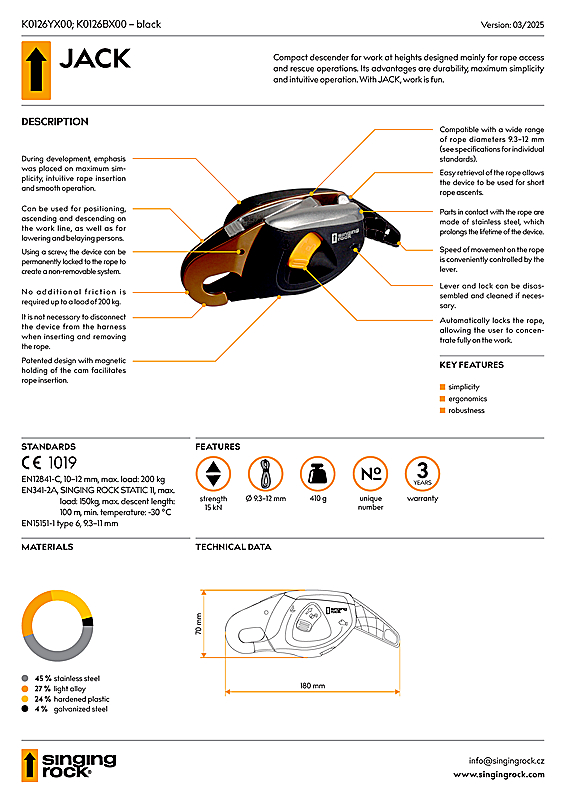Technical Details
Ondřej Belica of Climbing CZ sent me this Singing Rock Jack in 2025.
My Singing Rock Jack is 177 mm. tall, 67 mm. wide, 55 mm. thick, and weighs 408 g.
The Rig is shaped like an inverted pear (or perhaps an avocado) with a handle on the back. There are two stamped aluminum plates with a variety of other parts attached. The rear plate is brown anodized 3 mm. aluminum, and serves as the main frame. The lower portion of this plate is bent forward, and a 14.5 by 26.5 mm slot serves as the clip-in eye.
The rear plate has several components mounted on it. Starting from the inside top, there is a 17 mm. thick notched triangular anvil. Below this to the left is a 50 mm. diameter pear-shaped bollard. Most of the bollard’s circumference is grooved to guide the rope. The upper left side of the main bollard is extended so that the rope can run between it and the anvil. The main bollard can be rotated counterclockwise about 30 degrees using the handle. Releasing the handle allows the bollard to rotate clockwise, squeezing the rope against the anvil, stopping (or at least slowing) the descent.
A guide mounted to the bollard sits to the lower left of the main bollard. The guide keeps the rope from running over the plastic guide discussed next..
Finally, a plastic guide runs down the right side of the Rig. Its function is cosmetic. There is a countersunk hole in the rear plate, beside the clip-in eye, that aligns with a smaller diameter hole in the plastic guide. This is intended for a self-tapping screw to secure the guide, but my Jack came without such a screw.
The front plate is mounted and pivots on a small rivet attached to the center of the anvil. The fit is quite loose. This plate is stamped into a more complex form than the rear plate. The left side has a stainless steel casting riveted to the outside to create a rounded edge for the rope to run against. The front is covered by a plastic housing with a sliding button operates a latch for opening the Jack for rigging. A slot on the right side of the plate engages a groove in the bollard axle extension. A J-notch on the lower portion of the front plate lines up with the oval hole on the rear plate. The notch admits the seat maillon.
The normal rigging path is to bring the rope down the left side, under the main bollard and above the guide, counter-clockwise around the main bollard and below the anvil, then out the top and over the anvil through its notch. The rope path is much like the classic bobbin rope path.
The main bollard is turned by the handle on the rear of the device. The handle pivots on an extension of the front post, and held on by a 40 mm. diameter aluminum fender washer. A clutch assembly controls the motion. The clutch is not visible without destroying the device. A light spring raises the handle to the lock position, but the bollard is generally free to rotate, except a hidden mechanism tends to hold it in the open position. As a result, the behavior of the device on rope is quite different than one would expect after examining the device in the hand. The device works as follows: When viewed from the front, the normal descending position is with the handle at 10 o’clock. The rope friction is turning the bollard so that the rope is squeezed against the anvil Pulling down (counter clockwise) on the handle turns the main bollard counterclockwise, which releases the rope.
The front plate housing is printed with the Singing Rocks up-arrow logo and "singing rock." A molded line with a molded hand at the top and a molded anchor at the bottom suggests but does not fully show the correct rigging. The yellow latch has an arrow and an unlocked lock icon molded into its front. When unlatched, an inverted white danger icon appears. The rear plate is printed with "CE," 1019." the Singing Rocks up-arrow logo, "singing rock," a book-with-an-"i" icon, "2274K0126 425," an IQR code, and "JACK." The handle washer is printed with "Pat. No. 37746," and "Made by SINGING ROCK s.r.o., 514 01 Poniqlá 317, Czech Rep."
The Jack is similar to the Petzl Rig, and users of one should easily be able to adapt to the other.
Like the Petzl Rig, it lacks the annoying (and to my mind questionable) anti-error catch found on Petzl's I'Ds.
Also like the Petzl Rig, the Jack has hidden parts that make me hesitant to take it into muddy environments, but the Jack wasn't really designed as a caving descender, so enough said.




